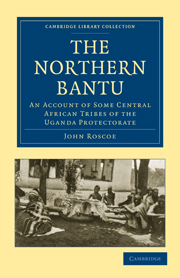Book contents
- Frontmatter
- PREFACE
- Contents
- LIST OF ILLUSTRATIONS
- Uganda and British East Africa
- PART I THE BANYORO A PASTORAL PEOPLE
- PART II THE BANYANKOLE A PASTORAL TRIBE OF ANKOLE
- PART III THE BAKENE, LAKE DWELLERS
- PART IV THE BAGESU A CANNIBAL TRIBE
- PART V THE BASOGA
- CHAP. XIX NORTH-WESTERN DISTRICT, CENTRAL DISTRICT AND SOUTHERN DISTRICT
- CHAP. XX MARRIAGE AND BIRTH CUSTOMS
- CHAP. XXI SICKNESS, DEATH AND BURIAL
- CHAP. XXII GOVERNMENT, INDUSTRIES, PLEASURES, BUILDING AND WARFARE
- CHAP. XXIII RELIGIOUS BELIEFS
- PART VI NILOTIC TRIBES. THE BATESO AND THE KAVIRONDO
- INDEX
- PUBLICATIONS OF THE CAMBRIDGE UNIVERSITY PRESS RELATING TO AFRICA
- Plate section
CHAP. XXI - SICKNESS, DEATH AND BURIAL
Published online by Cambridge University Press: 07 September 2011
- Frontmatter
- PREFACE
- Contents
- LIST OF ILLUSTRATIONS
- Uganda and British East Africa
- PART I THE BANYORO A PASTORAL PEOPLE
- PART II THE BANYANKOLE A PASTORAL TRIBE OF ANKOLE
- PART III THE BAKENE, LAKE DWELLERS
- PART IV THE BAGESU A CANNIBAL TRIBE
- PART V THE BASOGA
- CHAP. XIX NORTH-WESTERN DISTRICT, CENTRAL DISTRICT AND SOUTHERN DISTRICT
- CHAP. XX MARRIAGE AND BIRTH CUSTOMS
- CHAP. XXI SICKNESS, DEATH AND BURIAL
- CHAP. XXII GOVERNMENT, INDUSTRIES, PLEASURES, BUILDING AND WARFARE
- CHAP. XXIII RELIGIOUS BELIEFS
- PART VI NILOTIC TRIBES. THE BATESO AND THE KAVIRONDO
- INDEX
- PUBLICATIONS OF THE CAMBRIDGE UNIVERSITY PRESS RELATING TO AFRICA
- Plate section
Summary
The causes of sickness. Methods of diagnosing sickness. Sickness is rarely if ever attributed to natural causes, but is generally said to be the result of magic or of ghostly possession; a medicine-man is required to discover the cause of sickness and inform the relatives who is its author; he also destroys the magic and prescribes remedies for the sick person after the spell has been removed. There are various tests used to discover whether it is magic which is causing the sickness and if so who the guilty person is who has worked it. A favourite method used to discover magic is to fill a pot with water and place the pot in a sling used for carrying milk-pots; the medicine-man swings it round his head and, as he does so, he mentions the name of the man supposed to have been guilty of magic-making. If, after swinging the pot round several times, no water is spilled, the man is declared to be innocent, whereas, if some of it spills, he is pronounced to be guilty; should no water spill another name is repeated and the medicineman again performs the ceremony and goes on with name after name until the guilty person is discovered. The intestines of a goat or fowl are often used to discover the origin of sickness, when people can afford to supply the medicine-man with a goat or fowl.
- Type
- Chapter
- Information
- The Northern BantuAn Account of Some Central African Tribes of the Uganda Protectorate, pp. 222 - 229Publisher: Cambridge University PressPrint publication year: 2010First published in: 1915



